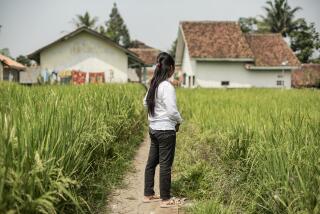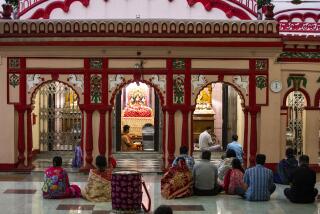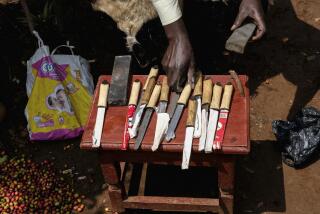‘Purified’ in the Name of Allah
AMBON, Indonesia — With her home destroyed and her church burned to the ground, 14-year-old Marina Rumakur knew there was only one way to survive: Convert to Islam and submit to a painful rite of mutilation.
Trapped by Muslim extremists on the tiny Indonesian island of Kesui, she and more than 900 fellow Christians surrendered. Hundreds of Roman Catholics and Protestants were forced to undergo female genital excision or male circumcision with kitchen knives and razor blades as the island was “purified” of all its Christians. The victims ranged from a 6-year-old girl to a 74-year-old woman.
“They said if we didn’t convert to their religion, they would cut our throats,” the teenager recounted. “We prayed and prayed there would be a ship to save us.”
The people of Kesui have been caught up in a vicious war of religious cleansing that has swept through Indonesia’s Molucca Islands over the last two years. Largely hidden from the outside world, the conflict has claimed at least 5,000 lives and driven more than 500,000 people--a quarter of the Moluccas’ population--from their homes.
Throughout the Moluccas, once known as the Spice Islands, Muslims and Christians who previously lived side by side now attack one another and burn one another’s homes. Here in this provincial capital, the two factions live behind barricades in segregated enclaves. On many islands, entire villages of Muslims or Christians have been wiped out.
While both sides are guilty of launching attacks and committing atrocities, the forced conversions have been carried out almost entirely by the Muslim side. The Muslims also are the only ones to force religious converts to undergo genital cutting, which is not part of the Christian tradition.
Christian leaders and refugees say more than 5,800 members of their faith on seven islands have been forced to convert to Islam over the last year. On at least one island, scores of converts have been kept as slaves by Muslims, according to a youth who escaped.
Refugees who set to sea in decrepit boats to flee the fighting sometimes never reach land. Nearly 500 fugitives, mostly Christians from the island of Halmahera, drowned in June when their overloaded ferry sank in rough waters. Last month, 22 Muslim refugees fleeing the hostilities on Halmahera died when their boat sank.
The Indonesian government appears powerless to end the war. Military units sent to keep the peace in the scattered group of about 1,000 islands have instead joined the fighting--usually on the Muslim side--while police have often sided with the Christians. At times, soldiers and police officers have fought and killed one another.
“To me, this conflict is a tragedy of humanity,” said Msgr. Petrus Mandagi, the Catholic bishop of the Ambon diocese, who has appealed to the United Nations and the United States for help. “If the government cannot solve this conflict, I think the international community should intervene.”
Jihad Extremists
The fighting in the Moluccas has much in common with the “ethnic cleansing” in Bosnia-Herzegovina and the Serbian province of Kosovo, but because of the islands’ remote location, the conflict here has received far less attention.
Reliable figures are hard to come by, but about 60% of those killed have been Muslims. Roughly half the refugees are Muslim and half Christian.
With the help of men and arms from outside the region, the Muslim fundamentalists appear to be gaining the upper hand. One extremist group--the Laskar Jihad, based on the island of Java--has declared the conflict a holy war and sent 4,500 trained fighters from other parts of the nation to seize the Moluccas for Islam.
“Waging a holy war in Molucca is obligatory for all Muslims in Indonesia,” proclaims the Laskar Jihad Web site, https://www.laskarjihad.or.id.
Christian fighters say identity cards found on the bodies of some white-robed jihad warriors show that they have come from Afghanistan, Pakistan and the Middle East.
Muslim leaders reject the notion of U.N. intervention and say the solution to the conflict is permanent partition along the lines established by the fighting.
“I don’t think it’s possible even in the next 25 years for the Christians and Muslims to live in harmony,” said Malik Selang, general secretary of the Indonesian Muslim Council in Ambon. “What the Christians already have and what the Muslims have should be their areas.”
Indonesia, which is 88% Muslim and 9% Christian, has the largest Islamic population of any nation. Until recently, the country had a reputation for tolerance.
Christianity in the Moluccas dates back nearly 500 years to the arrival of European traders seeking spices such as nutmeg, mace and cloves. During centuries of Dutch rule, many islanders converted to Christianity and gained a privileged status.
Under former dictator Suharto, who ruled Indonesia for 32 years until he was ousted in 1998, the government relocated Muslims to the Moluccas from other parts of the country, altering the religious balance and displacing the Christian elite. By the end of the last decade, the population of the Moluccas was 54% Muslim and 44% Christian.
With the end of Suharto’s military rule, the region was primed for an explosion. In January 1999, an argument between a Christian bus driver and a Muslim passenger in Ambon triggered a melee that spread throughout the city and to other islands. Churches, mosques and neighborhoods went up in flames and the killing began.
Today, both sides claim that they are the victims of aggression and that they are resisting a campaign by their enemies to create an independent religious state in the Moluccas.
“We can see there is a plan to Islamize the Moluccas,” said Emang Nikijuluw, who heads this city’s Christian defense force. “Anyone who doesn’t want to be killed has to convert to Islam.”
Islamic activists cite a case in which 50 Muslims reportedly were forced to become Christians on Halmahera in 1999. One person who refused to convert was killed, according to a woman who fled.
Kesui, with a population of about 3,000 before the conflict, is one of the most isolated places in Indonesia. It takes two days’ travel by ship to get there from Ambon, about 250 miles to the west.
Before the turmoil, fewer than 1,000 Christians lived in four villages on the island. Intermarriage between Muslims and Christians was not unusual, and some people changed religions when they married. A major difference between the two groups was that the Christians on the island liked to eat pigs and dogs, a sacrilege for Muslims.
Last fall, Muslims began warning Christians that they should convert to Islam or their villages would be attacked. The Christians refused.
In late November, scores of Muslims carrying spears, machetes and rifles assaulted the Christian villages. Some jihad warriors from outside the island were part of the attacking force, according to Christian refugees who were evacuated to Ambon in December.
Marina, the 14-year-old, said she fled into the jungle as the Muslims attacked her village, Karlomin. She could hear the attackers shouting “Allahu akbar!”--God is great. She watched from hiding as the militants torched the Catholic church and the rest of the village. “I cried when I saw them burn my house,” she said.
Convert or Be Killed
Marina said she was among 260 villagers who stayed in the jungle with little to eat for two days until Muslims found them and said the Christians would be saved if they converted to Islam.
Knowing they had little choice, she said, the villagers buried their Bibles and walked to the Muslim village of Amarlaud. The Muslims searched their possessions for religious artifacts and assigned the newcomers to live with families in the village.
Word spread that two Christian teachers who refused to convert were killed in other villages.
“They asked all of us if we really meant to convert to Islam,” Marina said. “We didn’t answer the first time. The second time I said yes, but really in my heart I didn’t.”
Several days later, the Muslim leaders announced that the converts would undergo circumcision or excision. Marina said she objected but was told that she would be killed if she didn’t go along.
Indonesian Muslims have had a tradition of female genital excision--the removal of all or part of the clitoris--before girls reach puberty. Sometimes called female circumcision, the practice has declined in recent years in urban areas but is still common in remote regions such as Kesui.
Muslim boys in Indonesia typically are circumcised using a local anesthetic when they reach age 10 or so. Often, a group of boys will be circumcised together, followed by a celebration of their manhood.
When the time came, Marina was told to sit in the lap of an older Muslim woman while another woman, an Islamic teacher, performed the procedure without anesthetic. The razor blade had already been used on several women without being washed, Marina said.
The Islamic teacher promised that the procedure wouldn’t hurt any more than being bitten by an ant, but that was a lie. Marina said she yelled from the pain and began crying. Her sisters, Emiliana, 6, and Anselma, 8, also were forced to undergo excision.
Christina Sagat, 32, another Catholic villager from Karlomin, said she was among a group of women who underwent genital excision at the hands of a Muslim woman with a kitchen knife.
“When she cut the clitoris, she said, ‘This is to cleanse the dirt of dogs and pigs,’ ” Sagat recalled. “I wanted to be angry, but I couldn’t show that in front of them. I was afraid they would kill me.”
The women were told to wash in the sea afterward. No treatment or medicine was provided, Sagat said, although some women bought antibiotics at a local store.
Tommy Rusin, a Catholic who surrendered after five days in the jungle, said he was kept as a prisoner in the Muslim village of Tanah Baru. “If we had tried to escape, they would have found us and killed us,” he said.
When it came time for his circumcision, Rusin said, the imam who performed the procedure promised that it would not be painful. “But when he cut it, it really hurt and I screamed. When I screamed, he just laughed.”
The imam used the same razor for more than 30 people, Rusin said. Between cuttings, he wiped it on a white cloth. Some of the men got infections that lasted for weeks.
Rusin said his 74-year-old mother, Agustina, was the oldest woman to undergo excision. The oldest man circumcised was 86.
By December, word of the mass conversions reached Ambon. The government, which had ignored earlier such reports from other islands, sent investigators to Kesui.
One official wrote a confidential report declaring that the Christians were “forced to change their faith.” After the report leaked, the official went into hiding, fearing for his life.
Officials evacuated 172 converts. In January, 648 more were evacuated, leaving 81 former Christians who chose to stay.
“In Kesui, there are no Christians anymore,” said the Rev. Sammy Titelay, a Protestant who left the island. “It looks like Christian cleansing.”
The government, however, has changed its stance. Not wanting to offend Muslims, Molucca officials now contend that the Christians chose to change religions.
“Because they want to live, they asked to be Muslim themselves,” said Central Molucca Regent Rudolf Rukka, who headed January’s evacuation.
As for punishing those who burned down the Christians’ homes or killed the two teachers, Rukka said, the government can do nothing. “We can’t find them,” he said. “We don’t know where they came from.”
Many of the Kesui refugees who were brought to Ambon live in a church hall not far from the hulks of buildings burned in the fighting. They quickly converted back to Christianity, but there is no restoring what they lost in Kesui.
“I feel ashamed, and I feel incomplete,” Sagat said. “I feel like I don’t have dignity. Everyone feels the same way.”
*
Tomorrow: The boys of Ambon go to war in the name of religion.
More to Read
Sign up for Essential California
The most important California stories and recommendations in your inbox every morning.
You may occasionally receive promotional content from the Los Angeles Times.










